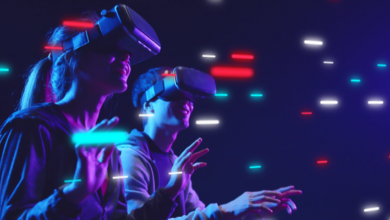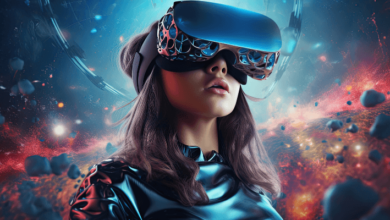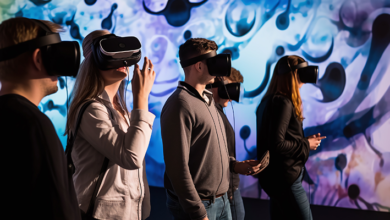What will AR /VR Headsets do to the Media & Entertainment Industry?

We often wonder, as technology advances: Will virtual reality be important for entertainment? Yes, it is.
The two most promising technologies of recent times are virtual and augmented realities. The media and entertainment industries are no exception. They can revolutionize how we engage with our environment.
The technologies that are changing the media and entertainment landscape will change how we view content. They also provide audiences with new ways to tell stories. We explore in this article the transformational impact of AR/VR on the entertainment and media landscape. Let’s get started!
What are AR and VR?
AR is a technology that overlays digital content on top of the physical world. VR, however, creates an entirely immersive virtual reality. Although both technologies are in early development stages, they have the ability to transform the way people interact with the digital universe. While VR creates immersive experiences that are captivating, AR allows you to convey instant information.
What future changes will AR/VR technology bring?
Recent advances in virtual and augmented reality have created a major revolution in media and entertainment. AR/VR head-sets were once futuristic, but are now more affordable and poised to influence the future of media consumption and engagement. Let’s explore how AR/VR headsets might affect the entertainment and media industry, emphasizing their transformational potential and emerging trends that will likely redefine the industry in the years to come.
Immersive Experiences Enhanced
AR and VR can give users the illusion that they’re inside the content. Customers can watch virtual reality concerts from their home, while augmented reality allows them to interact with the virtual world more closely.
AR/VR headsets provide a level of immersiveness that is unprecedented. Users can step into virtual environments or overlaid digital content on the real world. This allows viewers to experience films, television shows, concerts and other live events just as they would if physically there. Whether it’s sitting courtside at a basketball game or exploring distant planets, AR/VR headsets provide an immersive experience that transcends traditional screens, enhancing engagement and emotional connection.
It opens up an array of new possibilities in the entertainment and media industry. With AR/VR headsets, consumers can become active participants in the entertainment industry. We can expect an increase in the demand for AR/VR content on various platforms as these technologies evolve.
The New Content
The use of virtual and augmented realities can allow for new types of entertainment not previously possible. AR/VR head-sets can bring an entirely new dimension of interactivity and excitement to performances and live events.
At the Guns N’ Roses concert in Bogota, Colombia, Johnnie Walker and Diageo collaborated with Aircards to design an AR light show experience to provide fans with a unique brand experience.
The use of augmented reality overlays to enhance performances, such as concerts, sports, and theatre, can be a great way to add value. They provide real-time info, visual effects that are immersive, and experiences tailored for the audience. AR-enabled headgear allows attendees to interact with virtual elements and performers. It also lets them customize the viewing experience.
Advertising in the New Era
AR/VR headsets are a great tool for both marketers and advertisers. AR/VR headsets allow for immersive, interactive experiences in advertising. AR/VR can be integrated into digital marketing, allowing brands to create virtual showrooms or allow users the opportunity to test products in a virtual environment. Brands may also choose personalized ads based upon user location and preferences. This opens up new channels for interaction and allows advertisers to create more memorable and impactful campaigns. For media and entertainment marketers to stay competitive, they need to monitor the latest developments in marketing and quickly adapt.
AR and virtual reality may increase engagement with users by giving them the opportunity to interact more personally with ads. Advertising based on augmented-reality will allow users to view a brand new vehicle in their driveway. Doesn’t that sound intriguing?
Media and Entertainment Industry Using VR and AR now
Gamer
Gaming is the most popular form of leisure time entertainment. One of the most popular forms of entertainment today is gaming. Thanks to technology advancements, people can now make a career out their love for the game. The widespread adoption of AR and VR is exciting for everyone, but especially the gaming industry. AR and VR have been used in the past to create more immersive games. To give an example, the game “Pokemon Go” uses augmented reality to allow players to catch Pokemon in the real world. This means that you can see Pokémon appear in your surroundings as if they were actually there. Fernando Gomez believes, as a professor of virtual reality, augmented reality, and IED Madrid at IED Madrid does, that this type of application is fundamental to bringing the new technology to the masses.
Gaming industry has embraced AR/VR headsets quickly, changing the way that games are experienced and played. They transport users into virtual environments where they are able to interact with characters and other objects. This brings a new level of interaction and realism. Moreover multiplayer virtual reality games can provide users with a fun social experience that bridges the gap between digital and real-life social interaction. The AR/VR headsets, which offer immersive story-telling adventures and competitive multiplayer games, have opened new gaming frontiers, drawing a larger audience to the genre.
Virtual Cinemas, Theater Experiences
AR/VR headgear could completely change the way we view films and watch theatrical performances. Virtual theaters allow customers to customize their movie-watching experiences. They can pick the setting they want, select seating and participate in an online viewing with friends. According to mixed-news, Apple’s new release of AR/VR headset, Apple Vision Pro, will include a cinema feature enabling users to project movies and TV shows onto a giant virtual screen. Disney+, a streaming service that Apple Vision Pro owners can access in addition to Apple TV+, is an additional option for Apple Vision Pro.
These experiences are similar to the virtual theater experience that allows consumers to watch live performances in their own homes. They remove geographic restrictions and allow access to cultural experiences.
Film and Television
Since more than 100 years, film has provided entertainment to people around the globe. It is now the field actively searching for ways to apply and adapt virtual reality technology and concepts. The virtual reality technology allows the viewer to be an active participant in the story and see it from different perspectives. Filmmakers can also use AR to add additional visual effects or information onto a real-world setting, improving the experience of the viewers. The fusion between the digital and physical worlds opens up new storytelling possibilities and opportunities for content creators.
It is also possible to use virtual reality for creating compelling and interesting advertising materials. You can create engaging trailers for the movie or marketing material that is enticing.
Sport
Virtual reality and augmented reality have had a significant impact on the sports industry. They’ve revolutionized the way that fans interact with sports they love and transformed the viewing experience. Virtual reality headsets enable fans to feel like they’re physically present at a game, providing a 360-degree view of the action. Fans can feel a stronger emotional attachment to their team by using virtual reality headsets. VR headsets allow viewers to experience being at the stadium even when they’re geographically far away. It opens new opportunities for viewing from a distance and extends the reach of fans beyond their local area.
Overlays that combine augmented and virtual reality can improve your viewing experience by providing real-time information, profiles of players, interactive elements, etc. Viewing virtual replays in different angles allows fans to analyze key points of the game.
Trigger XR, in partnership with Pepsi, Verizon, created a augmented reality event (AR) for the Super Bowl Halftime Show 2022. This would have allowed viewers to virtually travel to SoFi Stadium, Los Angeles, to watch live performances from artists such as Snoop Dogg and Eminem.
Remaining Challenges AR/VR Face
Many challenges still remain. AR/VR adoption will be hampered by high costs, limited content and user-friendly interfaces. They are heavy and bulky, making them uncomfortable to use for long periods. Also, the technology consumes a lot of power which can limit the battery-life. Let’s assume the outer design has become utilitarian. There are also other issues, like software limitations and the challenges associated with adapting to this new technology. Access to high-quality content for AR/VR is still limited. It is mainly because AR and VR content creation is expensive and more complicated than conventional content. People are reluctant to embrace cutting edge technologies. It is not surprising that the high price and low quality of content of VR/AR headsets make it more difficult for people to embrace the technology.
These challenges will likely diminish as the technology improves and becomes easier to access, opening up the door for a more immersive future.
You can also read our conclusion.
The AR/VR headsets have revolutionized gaming, transformed film and TV and enhanced live events. They are changing the way we engage and consume content. We can look forward to a world where AR/VR is integrated into everyday life, providing consumers and content creators with rich, quality experiences. The impact of AR/VR headsets on the entertainment and media industry cannot be denied.
AR/VR headsets will be at the forefront this virtual revolution in the future media and entertainment industries.
Continue reading the entire article You can read more about it here







